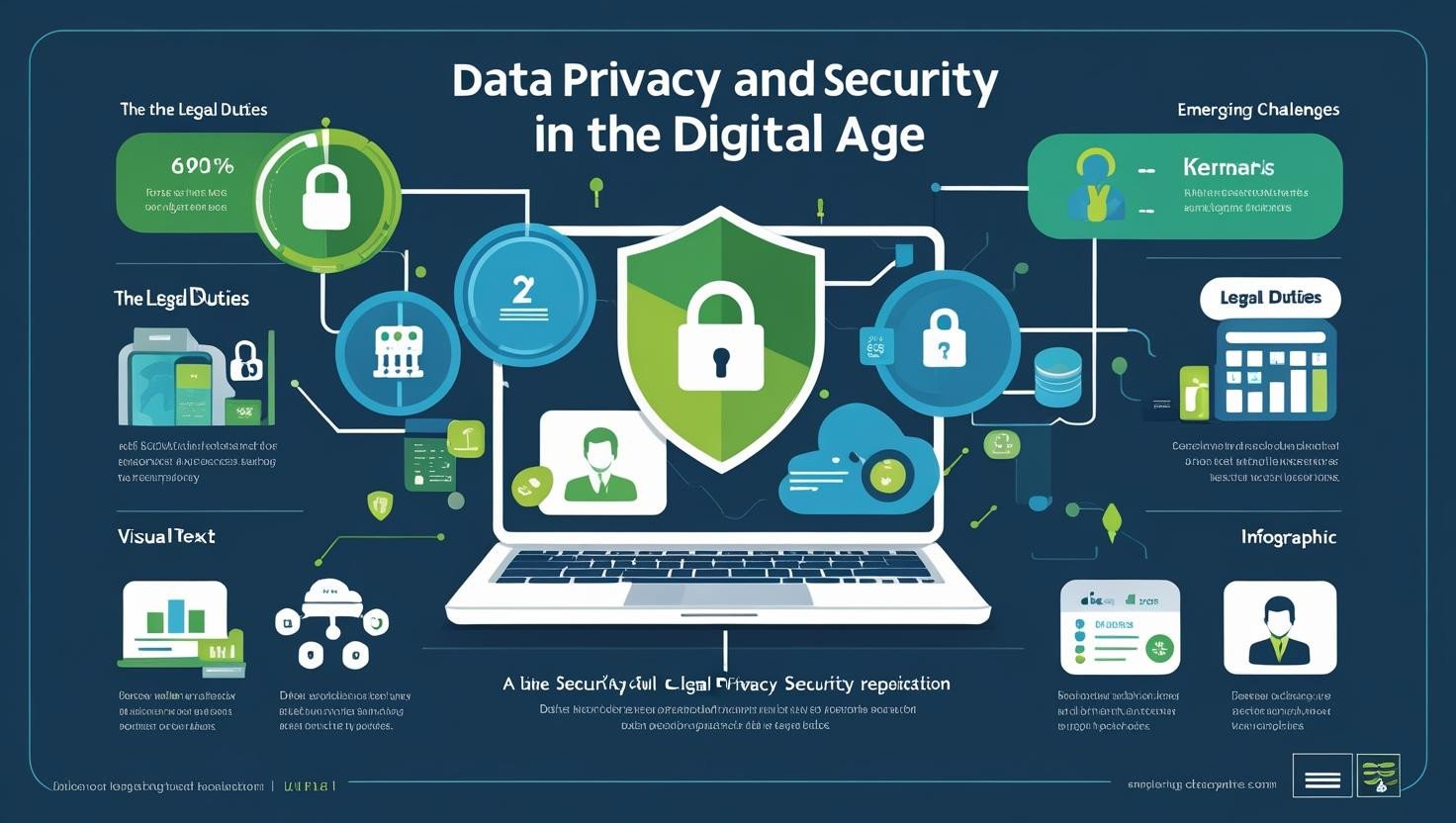
Abstract
In an era
defined by digital transformation, the protection of personal data has become a
critical concern. With cyberattacks and data breaches rising sharply, the
importance of data privacy and security has gained global recognition. The
General Data Protection Regulation (GDPR), introduced by the European Union,
sets out stringent obligations for organizations handling personal data,
demanding both robust data security and respect for individual rights. This
article explores the key legal duties imposed by the GDPR on data controllers
and processors, focusing on Articles 5, 6, and 32. It examines the nature of
contemporary cybersecurity threats, evaluates landmark enforcement cases such
as Google LLC v CNIL and the H&M breach, and assesses the challenges
faced by organizations in achieving compliance. Through legal analysis and
practical insights, the paper concludes with recommendations for safeguarding
privacy and maintaining accountability in the face of evolving digital risks.
Introduction
Personal
data is a valuable asset in today’s digital economy, but it also represents a
significant risk when improperly handled. The explosion of data-driven
technologies has dramatically increased the volume, sensitivity, and exposure
of personal information, making it a prime target for malicious actors. Major
data breaches have affected millions of individuals and raised critical
questions about accountability and legal protection.
The
General Data Protection Regulation (GDPR), effective since May 25, 2018,
represents the European Union’s response to these concerns. It seeks to
harmonize data protection standards across member states and grant individuals
greater control over their personal information. This paper examines the legal
duties under the GDPR related to data privacy and security, outlines the threat
landscape, and identifies key compliance challenges. It argues that while the
GDPR provides a strong framework, ongoing diligence and adaptation are required
to uphold privacy in an era of constant digital change.
Legal Background: GDPR and Data Protection
Obligations
The GDPR
applies to any entity that processes the personal data of individuals within
the European Economic Area, regardless of where the organization is based. The
regulation establishes a wide array of obligations for both data controllers
(those who determine the purpose and means of processing) and processors (those
who handle data on behalf of controllers).
Core Principles (Article 5)
Article 5
of the GDPR outlines fundamental principles for data processing:
- Lawfulness,
fairness, and transparency
- Purpose
limitation
- Data minimization
- Accuracy
- Storage
limitation
- Integrity and
confidentiality
- Accountability
These
principles must be embedded into every stage of data processing and supported
by clear documentation and policies.
Lawful Basis for Processing (Article 6)
Organizations
must establish a lawful basis for processing personal data. Common bases
include:
- Consent
- Performance of a
contract
- Legal obligation
- Vital interests
- Public interest
- Legitimate
interests of the controller, balanced against individual rights
Security of Processing (Article 32)
Article 32
mandates the implementation of appropriate technical and organizational
measures to ensure a level of security appropriate to the risk. This includes:
- Pseudonymization
and encryption
- Ensuring
confidentiality, integrity, availability, and resilience of systems
- Ability to
restore data access in case of an incident
- Regular testing
and evaluation of security measures
Modern Threat Landscape and Legal Implications
The threat
landscape continues to evolve. In recent years, ransomware, phishing, insider
threats, and supply chain attacks have dominated headlines. The MOVEit breach
(2023), for example, affected governments and private firms across multiple
countries, exposing sensitive personal and corporate data. Under the GDPR, such
incidents trigger significant obligations, including breach notification within
72 hours (Article 33).
Other
recent cases include the 2023 ransomware attack on the UK's Royal Mail, which
temporarily halted international deliveries and led to potential exposure of
customer data. Similarly, the 2023 data breach at Latitude Financial in
Australia, which compromised sensitive information of over 14 million
individuals, demonstrates how even sophisticated organizations can fall victim
to evolving threats. These cases highlight the urgent need for organizations to
go beyond compliance and implement holistic security practices that encompass
prevention, detection, and response.
Controllers
and processors must not only prevent breaches but also prepare for them.
Non-compliance can result in severe fines—up to €20 million or 4% of global
annual turnover, whichever is higher. In addition to financial penalties, data
breaches erode public trust and can result in long-term reputational damage
that affects business continuity and customer loyalty.
Case Study 1: Google LLC v CNIL (2019)
This
landmark case involved a dispute over the scope of the "right to be
forgotten." The French regulator, CNIL, had ordered Google to delist
certain search results not just within the EU, but globally. The Court of
Justice of the European Union (CJEU) ruled that the GDPR does not require
global de-referencing, highlighting the balance between data protection and
freedom of expression. This case underscored the GDPR’s extraterritorial limits
and emphasized proportional enforcement.
Case Study 2: H&M GDPR Fine (2020)
In
Germany, clothing retailer H&M was fined €35.3 million for excessive and
covert surveillance of employees, including the recording of health and family
information. The company failed to demonstrate a lawful basis or data
minimization, violating Articles 5, 6, and 9. This case illustrated the
importance of transparency and appropriate access controls within internal data
governance. In response, H&M implemented training programs and a new
privacy compliance infrastructure—emphasizing that remediation is an essential
element of enforcement.
Recent Legal Commentary (2023–2024)
Recent
scholarship has focused on the GDPR’s adaptability to AI and big data
environments. Peoples (2025) argues that while GDPR offers a strong base, the
complexity of algorithmic systems introduces accountability gaps that
traditional compliance tools cannot fully address. Similarly, Barrett (2023)
emphasizes the need for dynamic risk management and the integration of
privacy-by-design in modern systems.
Other
scholars, such as Munde and Koller (2023), have explored the intersection of
GDPR and cybersecurity frameworks such as ISO/IEC 27001. Their work underscores
the benefits of aligning legal compliance with technical standards, promoting a
cohesive approach to risk management and privacy assurance. Gervais (2017)
provides a broader copyright-focused lens, suggesting the need for
international reform to accommodate digital shifts, while Bygrave (2014)
outlines foundational principles of data privacy law that remain relevant in
today’s regulatory landscape.
Compliance Challenges and Best Practices
Despite
legal clarity, organizations often struggle to implement GDPR-compliant
systems. Common issues include:
·
Inadequate risk assessments
·
Over-reliance on outdated security technologies
·
Failure to keep policies and procedures updated
·
Poor employee training on data handling
·
Lack of integration between legal, IT, and operational departments
Best Practices Include:
·
Data Protection Impact Assessments (DPIAs): especially for high-risk
activities (Article 35)
·
Strong Access Controls and Encryption: to protect integrity and
confidentiality
·
Regular Audits: to evaluate system resilience and policy effectiveness
·
Clear Breach Response Plans: including timely notification and
mitigation
·
Training and Awareness Campaigns: to instill a culture of privacy across
the organization
·
Adoption of Privacy-Enhancing Technologies (PETs): such as homomorphic
encryption and federated learning to minimize exposure
·
Alignment with International Frameworks: including ISO/IEC 27001, NIST
Cybersecurity Framework, and ENISA guidelines
These measures,
when integrated into a comprehensive data governance strategy, enhance not only
compliance but also operational resilience and trust.
International Perspectives on Data Protection
While the
GDPR remains a gold standard for data privacy, global counterparts offer
varying degrees of protection. For instance, the California Consumer Privacy
Act (CCPA) grants U.S. consumers rights similar to those under the GDPR—such as
the right to know, delete, and opt out of data sales—but it lacks the GDPR’s
comprehensive structure and strict breach notification timelines. Meanwhile,
China’s Personal Information Protection Law (PIPL), enacted in 2021, emphasizes
state oversight and requires localization of sensitive data. These legal
variations present a challenge for multinational companies, which must navigate
multiple regulatory frameworks. However, convergence on principles like data
minimization and user consent indicates a growing global consensus on core
privacy values.
Conclusion
While the
GDPR represents a landmark effort in regulating data privacy, its
implementation in the digital workplace reveals a number of unresolved
tensions. Legal compliance often lags behind technological innovation, leaving
gaps in areas such as AI-driven decision-making, algorithmic transparency, and
international data transfers. Despite its strong foundational principles, the
GDPR alone cannot address all emerging threats—particularly those stemming from
opaque algorithms and the global nature of data ecosystems.
Organizations
frequently treat compliance as a checkbox exercise rather than a dynamic,
ethical responsibility. This reactive mindset undermines both employee trust
and long-term legal resilience. Moreover, the increasing use of workforce
analytics, biometric monitoring, and predictive systems raises serious concerns
about proportionality, informed consent, and surveillance creep—issues that the
current legal framework only partially addresses.
Looking
forward, a more integrated approach is needed—one that combines legal rigor
with ethical foresight and technical innovation. European lawmakers must
continue to refine the GDPR in light of real-world challenges, ensuring that
enforcement mechanisms keep pace with data practices. At the same time,
organizations should not wait for legal mandates to act. Proactive engagement
with data ethics, transparent governance, and inclusive policy-making will be
essential in shaping a digital future that respects both innovation and
individual rights.



